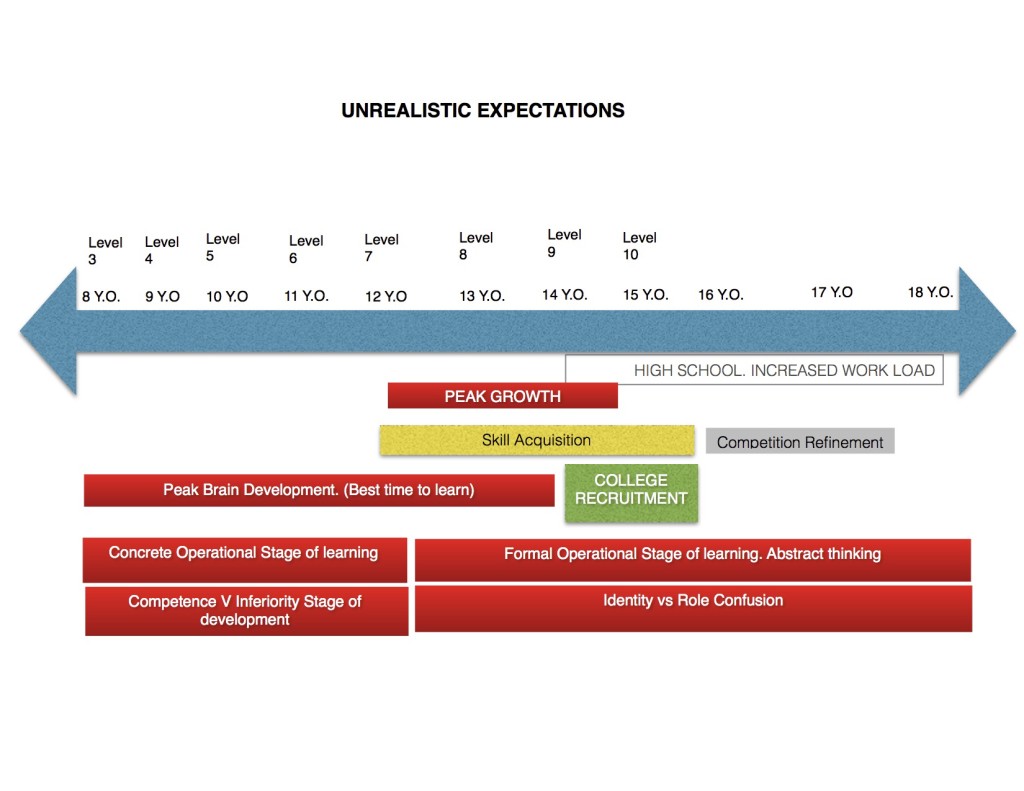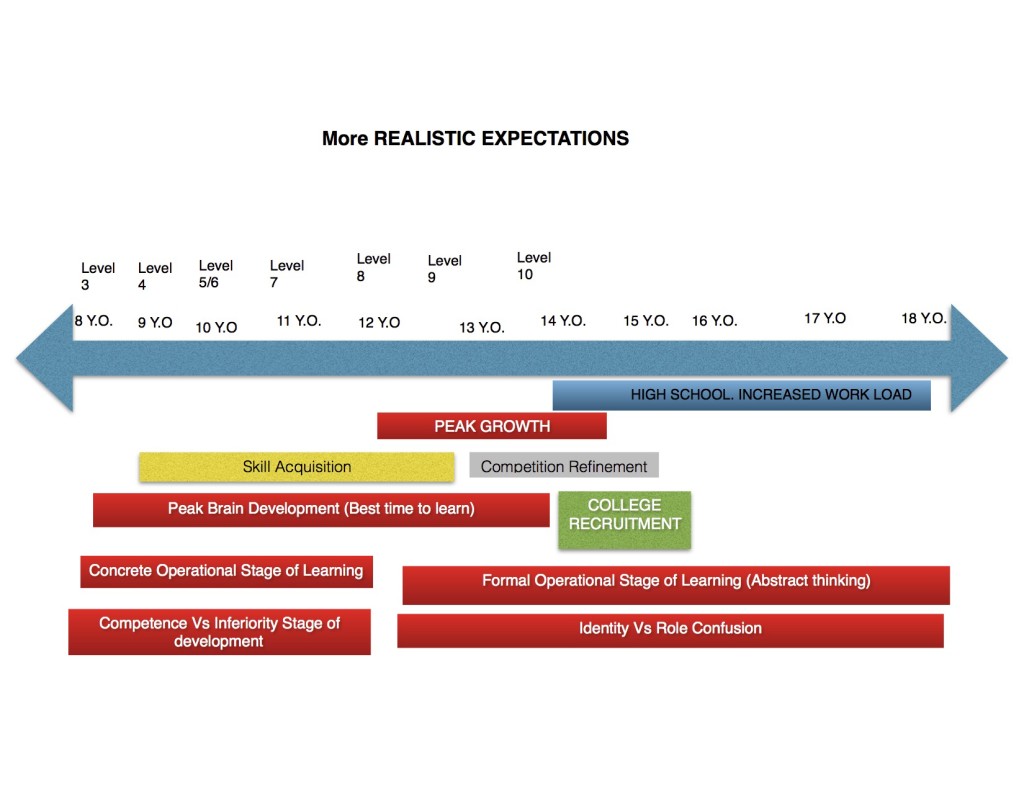Problems with Linear Gymnastics
All too often coaches get stuck in a linear thought process with the gymnasts.
Level 3, then Level 4, 5 etc.
Reality is that with this system- you will run out of time.
It has been noted by coaches much smarter than me that you need to introduce every skill a gymnast is going to have by they time they are 13 if they are realistically going to get the skills into a routine.
Take any advanced skill. For example a double back on floor. Although the skill is quite common these days, the technical demands are essentially the same as when it was first competed and thought to be too dangerous! What we have now is smarter coaches, more training devices, springier floors and softer landings.
If you first introduce a double back to a child at 13 years old (meaning the gymnast has NEVER flipped over twice anywhere) you will have approximately a year of drill work where they are being heavily spotted, tumbling up to mats, a lot of time on trampoline, many turns into foam pits before they are able to consistently do this skill alone. This time could certainly be MUCH, MUCH longer depending on the amount of time that can be spent tumbling, how much time spent on current skills and routines. Time loss due to injury or illness.
Now at 14 the gymnast is able to perform a double back alone.
At 14.5 years she may have the skill in her routine although it is possibly still inconsistent.
14.5 is also the age where many gymnasts experience an increased workload in school and will therefore be missing more training sessions.
Also take into account that between the ages of 11 and 14 females experience (on average) the most rapid period of growth. Through adolescence the increased mass a female gymnast adds can also slow things down.
15 years (Prime college recruitment age) a gymnast now has the skill (hopefully) consistently.
You can see the pitfalls of delaying the learning process by not introducing the skill at a young enough age. The gymnast will simply run out of time to have the skill in a routine.
Taking this back into the USAG compulsory program. The average age of the Level 3’s in most gyms is 8 years old.
If they do 1 level per year
Level 4 – 9
Level 5 – 10
Level 6 – 11
Level 7 – 12
Level 8 – 13
Level 9 – 14
Level 10- 15
You are simply going to run out of time. How can you take the USAG system and use it to the benefit of most gymnasts and certainly for the more talented gymnasts?
In order for us, as gymnastics professionals, to become more efficient, we need to understand growth and development of the gymnasts we work with.
Children are not just smaller versions of adults. They have very particular needs and capabilities. One of the major issues in gymnastics is a lack of knowledge on the part of coaches and parents about how children grow and develop. This ignorance places unrealistic expectations on the child and often causes them to give up the sport. Good coaches know and understand the many changes that take place from child to adult and structure their coaching to best suit the needs of the young athlete.
Some general rules:
● Think about growth stages rather than ages. Kids develop at different times.
● Think how changes in physical proportions will affect performance with certain skills
● Encourage skill learning at a younger age for all your athletes, late developers could be very successful later.
● Don’t use exercises which place excessive force on bone growth regions during periods of maximum growth (growth spurts)
Given the formula which many clubs use, you can see that we have set out unrealistic expectation on a great many of out gymnasts.
A more realistic timeline for long term development would have the gymnasts being introduced to most of their skills by the age of 13.
My reasoning is that developmentally it seems the best time to learn. They generally have not hit their growth spurt where you may end up having to scrap some skills that are no longer practical. They do not have a huge amount of school work and have the least amount of FEAR.
When ever I do a congress I always hear about this great 10 year old back in the gym. This gymnast is learning so fast she is going to be the next Olympic Champion. Then what happens? They grow, become afraid, have too much school work to train enough hours to finish the skills. My experience has shown me that you simply do not have enough time to introduce a skill , refine the skill and compete the skill after 13.5 years old.
In order to have program wide success you need to have a plan. A plan for each group and each individual. If you are doing 1 level per year. You are simply going to run out of time.
Questions to ask yourself-
What age will this group start competing?
Will they be skipping a level or at some point do 2 levels in 1 year?
What did I learn from the LAST GROUP that I will do differently?
What will I do the same?
What competitions do we NEED to be at (Large invitationals to see how you stand up on a Regional or National level)?
Should we get involved in USAG Developmental Camps or TOPs?
Are we looking at collegiate gymnastics or potential National Team?
What skills will these gymnasts need in 3 years?
In 5 years?
In 8 years?
With every group you need a plan. Ask these questions so that you have direction.






